As the four of them await a life when travelling is normal again, they reminisce on the journeys past.

Haddock’s first trip in Ireland. Here, he looks over the Carlingford Lough from Cooley Peninsula. The other side of the lough is the UK. He wonders whether Brexit might affect his whisky supply. / 06.08.16
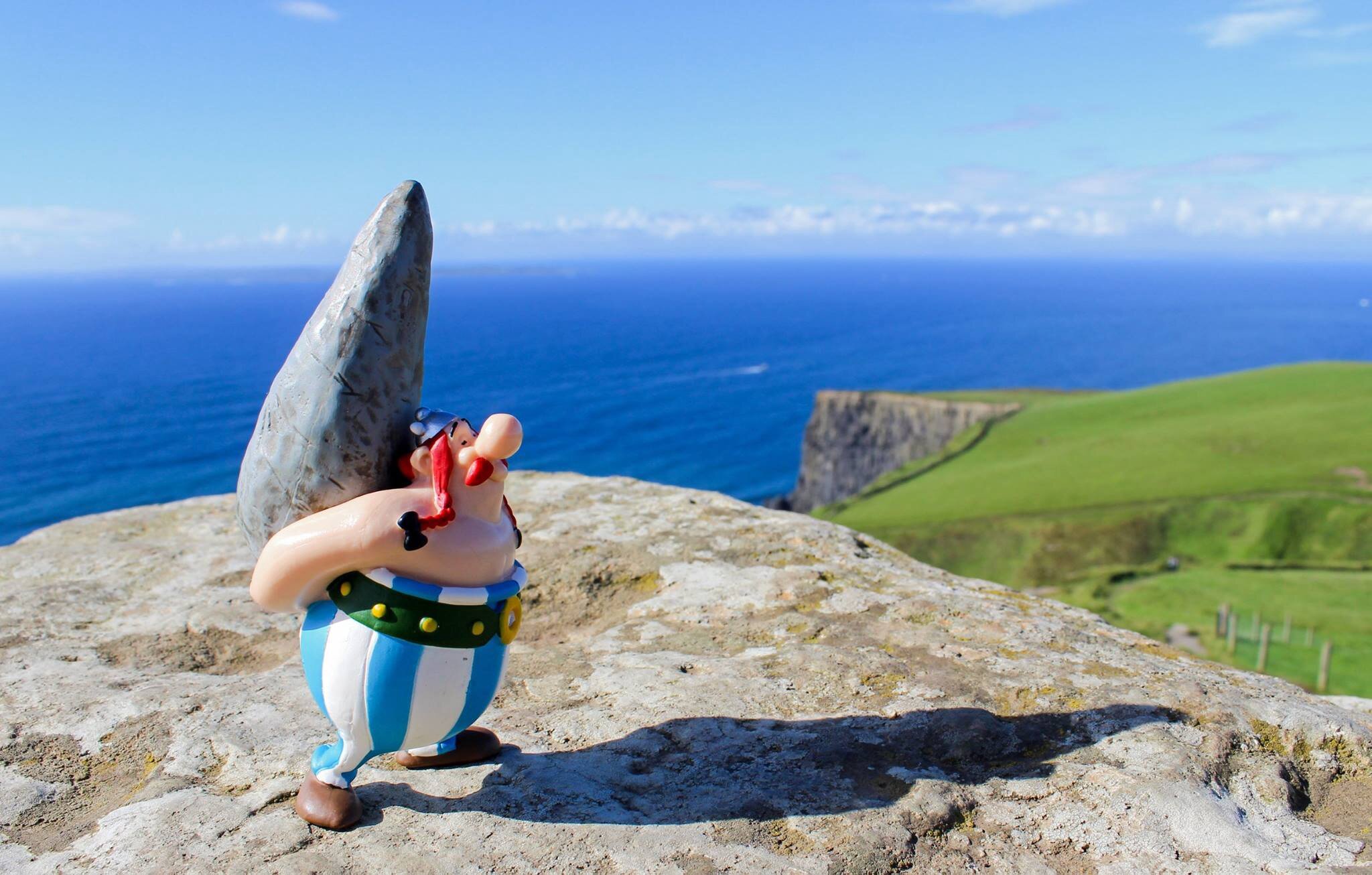
“Ils sont fous ces Irlandais!…these Irish are crazy!”, screamed Obelix as he stood on the flagstone wall built by Cornelius O’Brien along the length of the cliffs. He wouldn’t understand why they hadn’t already converted the stones into menhirs. He believed that the stones (and even the 70-meter sea-stack in the ocean!), were being wasted. Because the Irish and the Gauls share a Celtic history, he knew there had to be an Irish equivalent of the magic potion! Rejoicing that Getafix wasn’t around to stop him, he drank to his fill. “They drink it in pints here, and the Gauls won’t even let me have a sip..”, he complained after five pints of the Guinness. “I’m staying here… Are there wild boars in Ireland? /26.08.16

After a day of hopping tents listening to bands whose names he had never heard of till date, he relaxed his feet and found comfort in whisky. For the three days every year, the little town of Stradbally turns into a festival, with music that can be heard even as you drive into the outskirts of the town. With many many tents, colours, art installations, discussions, food, music and art — the sight is one to behold. Haddock loved being amidst people and chaos! His only complaint was that the Salty Dog At Electric Picnic had converted a ship into a stage. As a captain, he found it disrespectful to anchor a ship over a hundred kilometres away from the sea. He is seen here, visibly overwhelmed at a rainbow in the sky, while standing on a shroom. / 06.09.16

While his companion spent time in the midlands, Obelix took time to visit the wild west of Ireland, still in search of a place to call home. He heard of the impressive 15th Century Ross Castle made in stone and decided to pay a visit. Here, he’s seen standing on Brickeen Bridge, overlooking the Lough Leane, the largest of the three lakes in Killarney. On the other side of the lake lies the castle that Obelix hopes to make home. / 12.09.16

“Howth doesn’t exist”, Captain Haddock told me the other week… “its existence is a lie created and spread by ‘Them’.” Apparently, a German sailor once told him about the non-existing towns around the world that were illusions propagated by evil governments to cover up their shady activities. “Don’t be ridiculous”, I said. He started out by accusing me of being part of the conspiracy, and soon resorted to telling me I’m deceiving myself. Now confused, I decided to look it up, and read about the Bielefeld Conspiracy and its Irish version about Howth. There was only one way to convince Haddock — to take him to Howth! He is seen here, staring at the camera like his whole life has been a lie. Behind him is the Irish Sea and Ireland’s Eye. / 09.1016

“Ass to the Wind” — I think it’s the literal translation of the Tonelagee (“toin le gaoithe” in Irish) mountain that attracted Obelix’s attention this time. I’d told him it was snowing the last time I was there, and that the cliff is too windy for a small plastic toy to withstand. But he wasn’t to be convinced. So we set out with Matt and Thea south to the mountains. The views of the heart-shaped Lough Oular were cloudy, but this was of little interest to the brave Obelix. He was here to face the fierce south-Eastern winds rushing in through the Wicklow Gap — so he marched on towards the cliff. He’s seen here standing with the wind to his ass; the Wicklow gap behind him. / 12.12.16

On his first international trip, Obelix sees Bamberg. His favourite place was the dark labyrinth of tunnels under the old buildings of the city. In the middle ages, mining was done to search for sand used for scouring powder. In the 17th and 18th century wine, and later even beer and malt were stored here. During the Second World War, the individual tunnels were connected to make a long air-raid shelter. At one point, Bosch manufactured spark plugs and other electrical parts in one of the larger tunnels. In all, the tunnels under Stephansberg and Kaulberg hills amount to about 12 kilometres today. Obelix didn’t care too much about history. He was excited simply at the thought of the tunnels being filled with a magic potion in the 17th and 18th centuries. Here he is seen, standing by the river Regnitz. Behind him is the colourful old City Hall. / 14.03.17

Timon visits Galway. There was no containing his joy on a sunny day — he wanted to stop and dance with every singer on High street, and try every food-stall at the weekend market outside St. Nicholas’ Church. Once I pulled him away from the busy Latin Quarter, he had to be assured that the seagulls wouldn’t prey on him and that Ireland had no snakes before he was convinced to walk with me to Barna, a town west of Galway city. That night, he had his first pint of Galway hooker, and was very disappointed when we were told by the bartender that no matter what it sounds like, the name came from a specific kind of fishing boat that was used in the area. ‘Spanish traders would’ve taken the name back with them’. Galway used to be a major trading port, mostly with Spain. Back in the days, 14 merchant families dominated all forms of life in Galway city. We were also asked to visit the Blake castle which we did the next day. Timon sat by the river, looking at people rowing their boats on the Corrib, humming ‘Hakuna Matata’ under his breath. I remembered his line from the VHS tape of The Lion King that I had seen too many times as a child: ‘This is the start of a beautiful acquaintanceship’. He’s seen here standing on Claddagh Quay, river Corrib and the Galway Bay behind him.

For a Gaul, Abu Dhabi was unbearably hot. Attempts to make him wear a shirt while entering the mosque proved futile after the security guard couldn’t find something that fits. Inspired by the beautiful paintings on the wallpapers, Obelix wondered if he must try some calligraphy on his next menhir, but he wasn’t sure if the Gauls had a script. / 16.08.17

On a wet, rainy, grey day, Timon and Pumbaa decide to scale Carrauntoohil — Ireland’s highest peak. The rain poured down heavily for the full six hours. We were all soaked, cold and miserable. For the duo, however, it was an ideal getaway — running around and making small-talk with the grazing sheep, they seemed much at ease. It didn’t trouble them that there was no breathtaking view at 1,038 meters, they found a rock on a side and sat with the wind to their backs, staring intently into the dense fog that covered the peak. Seen here, waiting on a rock as the rest of us struggled to cross a wild stream behind. / 12.11.17

‘We could’ve made it to the top…The boulders on the top could make great menhirs’, Obelix said to us as he gulped down pints of the magic potion of Ireland. We couldn’t make it to the top of Mount Brandon because there was too much snow, but Obelix wasn’t to be convinced. He tried pacing up but came sliding down on the snow on his bottom. After two failed attempts, we lured him back into the tiny village of Cloghane by promising him pints. That evening, the only pub in the village — O’Connor’s Bar — had a nice little gathering. A lady on the accordion and a man on the bodhrán played some country tunes as different people from the village took turns to sing or say jokes out aloud. We left when Obelix suggested he’d sing one of Cacofonix’s tunes and say a joke about the Romans. He’s seen here nurturing a whiff of the freshest air while walking up Brandon. / 18.02.18
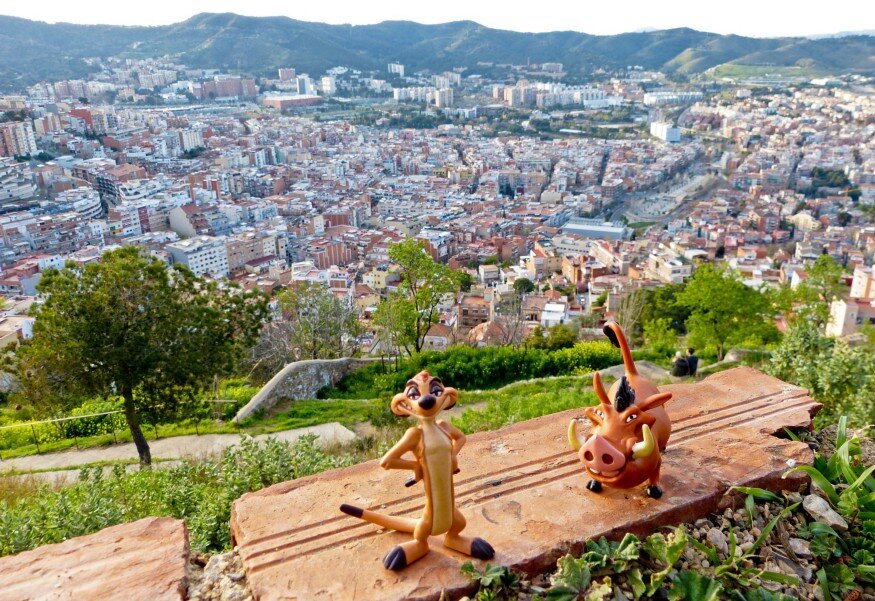
Much warmer weather meant these guys were uncontrollable in Barcelona. But then chasing them around the narrow alleyways was part of the fun. Their favourite view of the city was from the bunkers in the north of the city. Built as anti-aircraft fortifications in 1938, the area today is a popular spot with breathtaking views of Barcelona skyline, Sagrada Família, and the sea that lies beyond. But it was also crowded, which meant that Timon and Pumbaa chose the view north for their picture. / 31.03.18
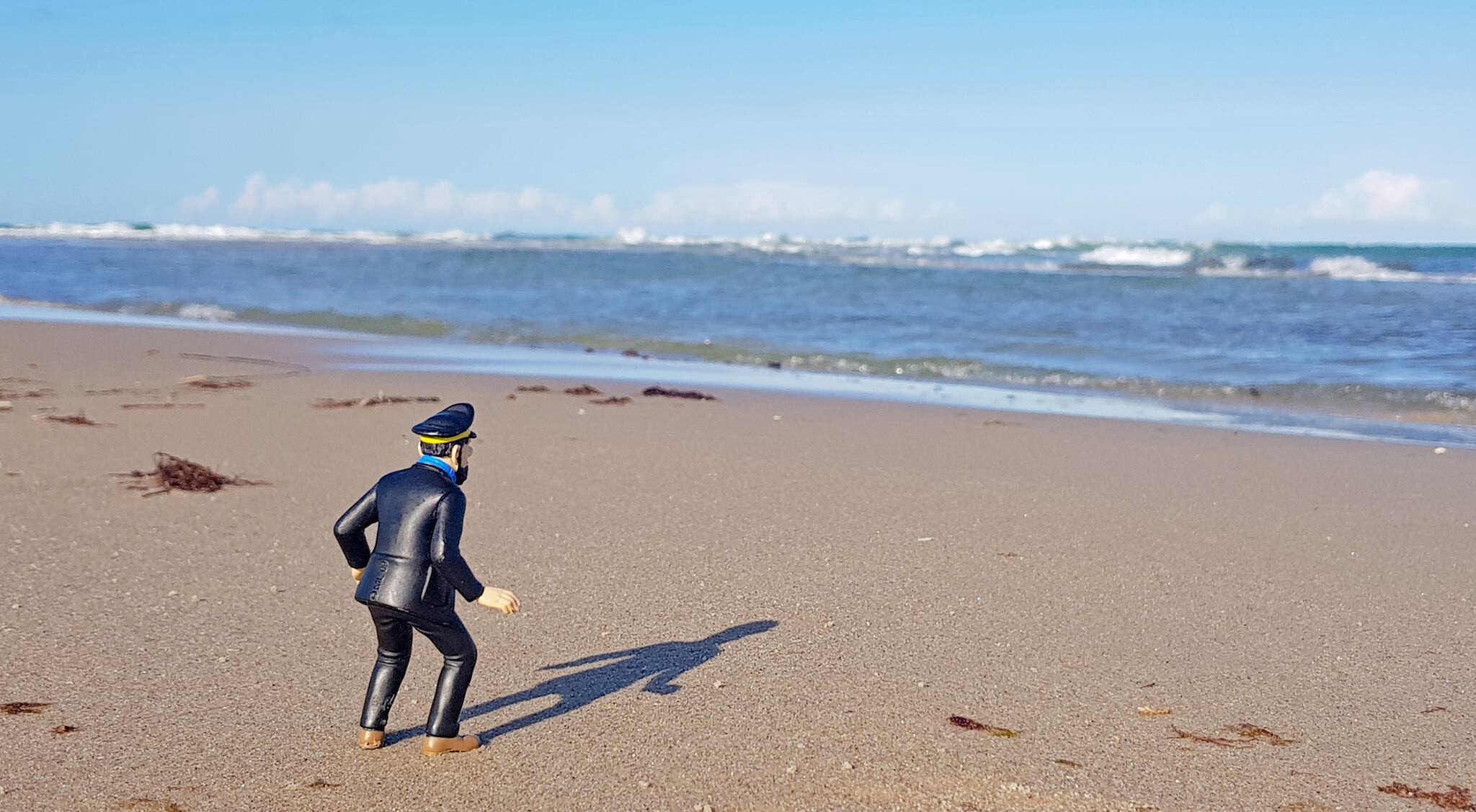
“Would you sail these seas?” I asked the Captain as we drove up to the northern tip of Jutland. “I’d sail any” came the quick reply as he sipped his whisky and rolled down the window of the car to catch the scents from the sea. We were driving up beyond the quiet town of Skagen, to the tip of Denmark where the Baltic Sea meets the North Sea. Waves of the two seas beat against each other, as though to fight for might. Perhaps as a result of this, the pebbles and stones on the beach were a mix of various colours patterns and contours. It was a beautiful day and we could see far into the distance where a number of container ships were sailing. “Imagine…this must have been a route for the Vikings a thousand years ago”, Haddock said as he stood on the fine sand staring into the sea. He was silent, but his eyes glittered / 02.09.18

Timon and Pumbaa refused to let me spend the day at home doing nothing, so we set out to see Pilanesberg National Park today. We didn’t spot any meerkats, but Pumbaa was more than happy to make acquaintance with the warthog family we crossed paths with. Seen here, they rest on a wooden pole with the Park behind them with savannah stretching out to over 500 sq.kms. The park is situated in a crated formed from volcanic eruptions from some 1300 million years ago, and have sites from the Iron and Stone Ages. But Timon and Pumbaa didn’t care. They’d had never seen a giraffe for real, and wondered if their necks swayed uncontrollably on a windy day. They were just happy we got to spot 4 out of Africa’s “Big-5” (lion, leopard, black and white rhino, elephant and buffalo) / 27.01.19

“Let’s buy that house by the hillside” “Which one?” “That white one. I’ll stay here” “That’s now how it works” “Bleeding blistering barnacles!” Wasn’t easy to convince the Captain to return from Donegal where we spent the last weekend. Can’t blame him. / 06.06.19
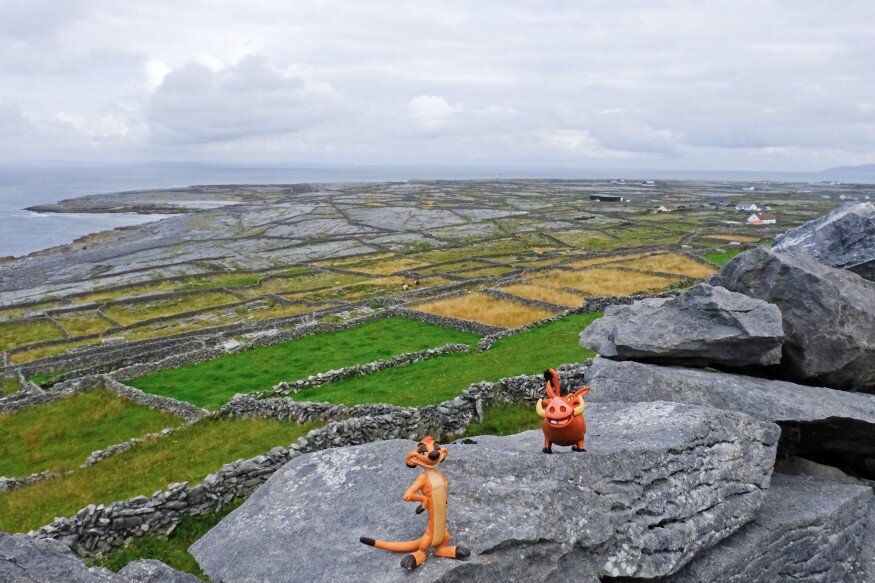
When you get off the ferry in Inis Meain, you also get back in time. There’s no shops or cafes near the pier, just a little shed to take cover when it rains, and a map with all the walks marked. The middle-island of the Aran Islands is home today to about 160 people, less than one-third of what it was before the famine. Presumably, this explains the small-sized plots (smaller than most landholdings I’ve seen in other parts of Ireland) divided with the un-ending stone-wall maze that welcomes a visitor. We stopped at two spots along the walk — Dún Chonchúir (Conor’s Fort), a stone-fort from pre-Christian times, and the breathtaking Cliffs of Inishmaan that could give the Cliffs of Moher a stiff competition. No wonder at all that this island is considered one of Ireland’s most traditional. Needless to say, Timon and Pumbaa were happy to have a much-needed break. They’re seen here atop a wall on the way towards the limestones that lead to the cliffs. Part of the island behind them, and the North Atlantic ocean beyond. /11.08.19
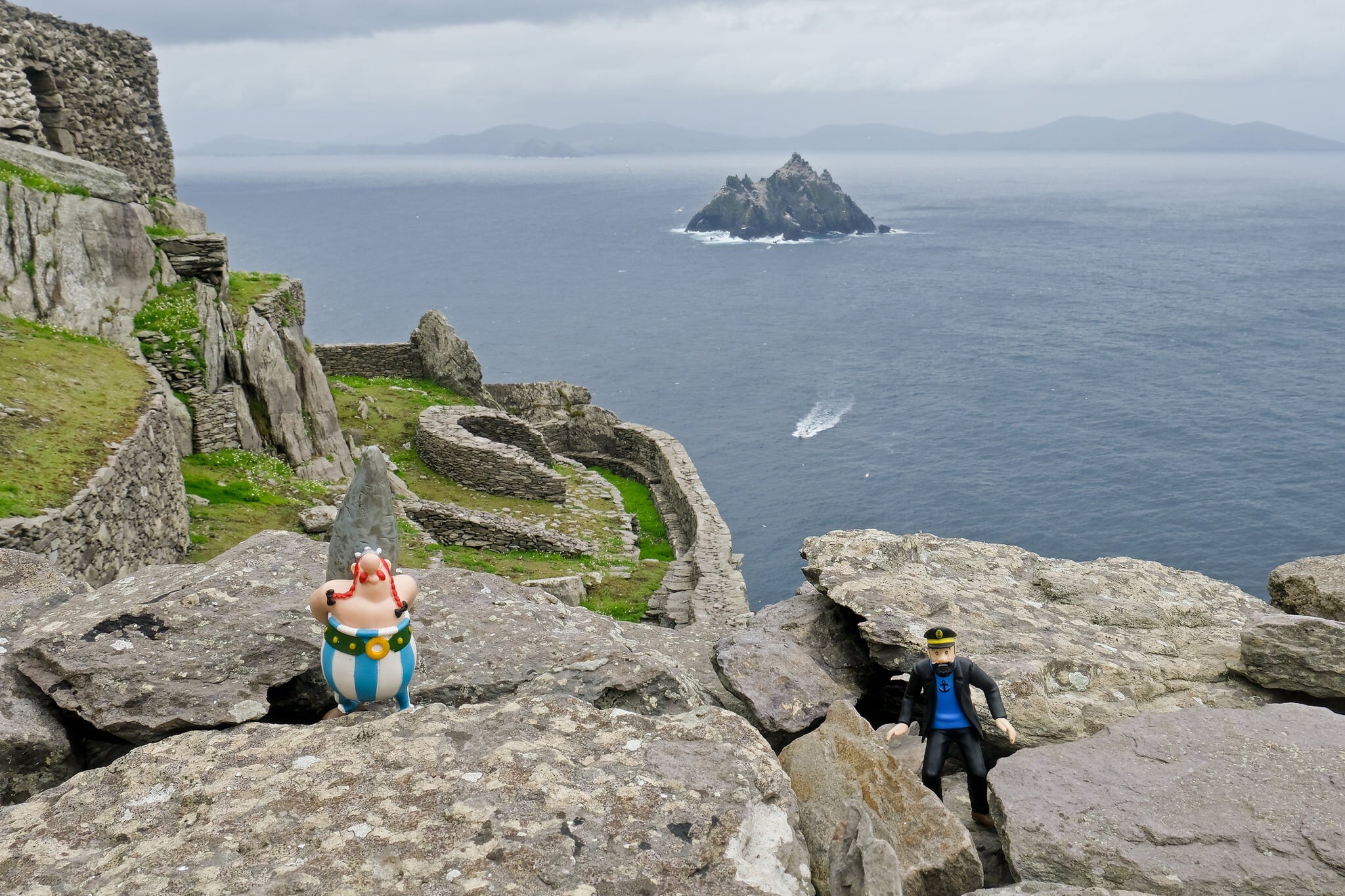
The larger of the two, Skellig Micahel, is famous for the clochán or beehive huts, part of a Gaelic monastery founded between the 6–8th centuries. Obelix wasn’t to stay put after he heard this. “They’re made of stones?” “Yes” “Are there menhirs?” “I don’t think so” “There might be. I’ll have to see to believe. I’m coming”. Secondly, getting to the island is tricky, which is partly why I had to wait so long. The island, not a UNESCO heritage site, is only open for visits in the summer months. One must make an online booking because only a few boat operators are licences to go out, and only a fixed number of people are allowed on the island each day. I had a spot, but you see the islands have no piers, so the boats’ getting out to them depends on the weather, wind speeds, tide conditions, and sea-swell. I received an email the day before we left Dublin, that the seas were extremely rough that week, so the possibility to get out to the islands looked bleak. “Bleak? Abecedarians! All they need is a good sailor (hic!)” Haddock had heard me read aloud the weather update “I don’t think it’s that” “This sounds like a rough ride. You need a strong sailor. I’m going”. / 09.10.19

When the French and the Irish squadrons fought the Battle of Tory Island in 1798, Fanad peninsula had no lighthouse the guide the ships. “Must’ve been quite some ask, navigating these waters”, I thought aloud. “Thundering typhoons!”, says Haddock. “What?”, I ask. “Nothing.” The lighthouse was built in 1812, following the shipwreck of the HMS Saldanha in the waters of Lough Swilly, one of Ireland’s few glacial fjords. It is said that the lone survivor from the wreck was the vessel’s parrot. “Lago?”, Haddock said. “What”? “Nothing” /02.10.20